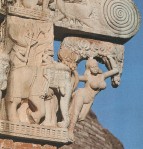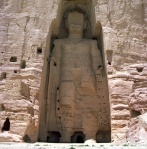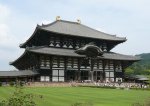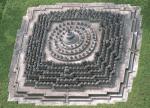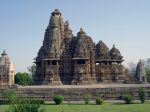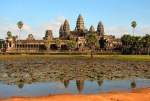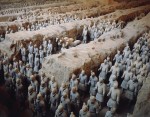Concurrent Dates
| 563-483 BCE | The Buddha |
| 499-479 BCE | The Persian Wars |
| 326 CE | Alexander the Great Reaches the Indus River |
| 325 CE | Council of Nicea |
| 476 CE | Rome falls |
| 1337 CE | The Hundred Year’s War begins |
Target Concepts
- Religions rooted in the East seek an end or escape from the karmic cycle or reincarnation
- Buddhism begins in India but spreads throughout the East
- As Buddhism spreads, so does its artistic and architectural styles
- Abstraction is frequently the answer when a culture wishes to depict the supernatural
- Eastern art heavily relies on iconography to convey a message
- Eastern art has its own canon and style that differs from the West
- When there is contact between the East and West, artistic styles influence one another
- Vectors of contact have included military conquest, the Silk Road, colonialism, and trade
Buddhist Art
Cycles
Reincarnation, karma
Buddhism and the Buddha
Great Stupa at Sanchi
India, 4th century BCE 50’ tall
King Ashoka, Circumambulation, torana, Yakshi
Seated Buddha, Gandhara style
Pakistan, 2nd century CE stone 2’
Urna, ushnisha
The Life and Death of the Buddha
Pakistan, 2nd century CE, schist 2’ x 9’
Bondi Tree, Sarnath
The Silk Road
Colossal Buddha of Bamiyan
Afghanistan, 2nd century CE 180’ tall
Seated Buddha preaching the first sermon
India, 5th century CE, tan sandstone 5’ high
Mathura Style
Longmen Caves
China, 5th – 12th century CE limestone
Vairocana Buddha, Nio
Jowo Rinpoche
Tibet, 7th century CE gilt metals with semiprecious stones, pearls, and paint
Daibutsuden (Kondo) of the Todai-ji complex
Japan, 8th century CE, rebuilt 18th century CE, wood, bronze, and ceramic tiles
Curtain walls, modular, mortise and tenon
- The Great Buddha of Todai-ji
- Gate and Nio Guardian Statue of Todai-ji
Borobudur Temple
Indonesia, 9th century CE volcanic stone masonry
mandala
Ryoan-ji Gardens
Japan, 15th century CE
Zen Buddhism
Hindu Art
Hinduism
Shiva, Vishnu, Devi, avatar
Lakshmana Temple
India, 10th century CE
Plinth, Tantric Hinduism
Shiva as Lord of Dance (Nataraja)
India, 11th century CE bronze
Mandorla or Nimbus
The temple of Angkor Wat
Cambodia, 15th century CE stone masonry, sandstone
- Churning of the Ocean of Milk
- Jayavarman Vii as Buddha
Art of other Traditions
Terra Cotta warriors from mausoleum of the first Qin emperor of China
China, 3rd century BCE painted terra cotta life-size figures
Funeral Banner of Lady Dai (Xin Zhui)
China, 2nd century BCE painted silk 6’8” tall
Gold and Jade Crown
Korea, Three Kingdoms Period 6th century CE metalwork 11″ high
Travelers among Mountains and Streams, Fan Kuan
China, 11th century CE hanging scroll, ink and colors on silk detail 3’ high, entire scroll is 7’ high by 3’ wide
Daoism
Night Attack on the Sanjo Palace
Japan, 14th century CE Hand scroll, ink and colors on paper 16” high
Hand scroll
The David Vases
China, 14th century CE white porcelain with cobalt-blue underglaze
Porcelain, underglaze
Portrait of Shin Sukju
Korea, 15th century CE hanging scroll (ink and color on silk)
Confucianism
Imperial Palace (The Forbidden City)
China, 15th century CE and later, stone masonry, marble, brick, wood, and ceramic tile
Feng Shui
White and Red Plum Blossoms, Ogata Korin
18th century CE ink, watercolor, and gold leaf on paper
The Great Wave off Kanagawa, Katsushika Hokusai
From Thirty-Six Views of Mount Fuji series
Japan, 19th century CE polychrome woodblock print 10”x1’
Chairman Mao en Route to Anyuan, based on a painting by Liu Chunhua
China, 20th century CE color lithograph
- The Great Stupa
- Yakshi
- Meditating Buddha from Gandhara
- The Life and Death of the Buddha
- Colossal Buddha of Bamiyan
- Seated Buddha preaching the first sermon
- Longmen Caves
- Bodhisattva and Nio
- Jowo Rinpoche
- Daibutsuden of Todai-Ji
- Great Buddha of Todai Ji
- Tirana of Todai Ji
- Nio from Todai Ji
- Borobudur Temple
- Ryoan Ji Gardens, dry
- Ryoan Ji Gardens, wet
- Lakshmana Temple
- Shiva as Lord of Dance
- Angkor Wat
- Churning of the Ocean of Milk
- Jayavarman VII as Buddha
- Terra Cotta Army of Emperor Qin
- Funeral Banner of Lady Dai
- Gold and Jade Crown
- Travelers among Mountains and Streams
- Night Attack on the Sanjo Palace
- The David Vases
- Portrait of Shin Sukju
- Imperial Palace
- White and Red Plum Blossoms
- The Great Wave
- Chairman Mao en Route to Anyuan


